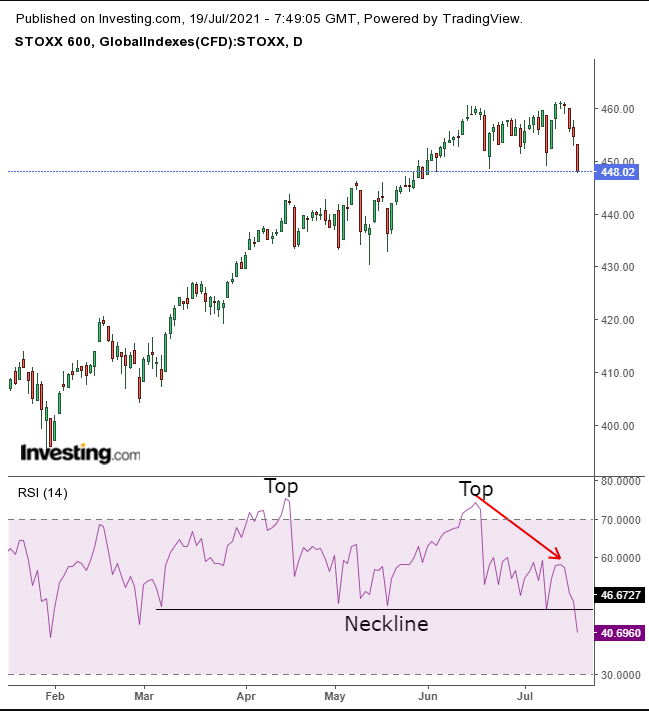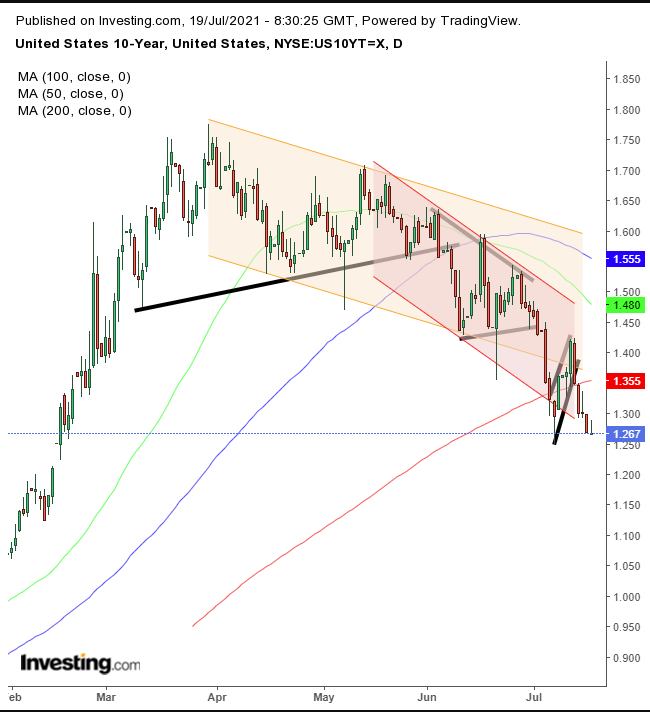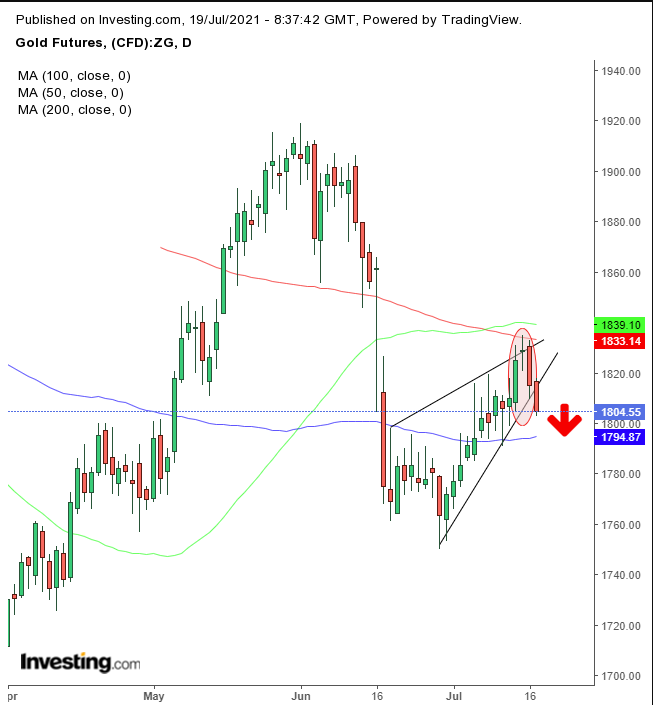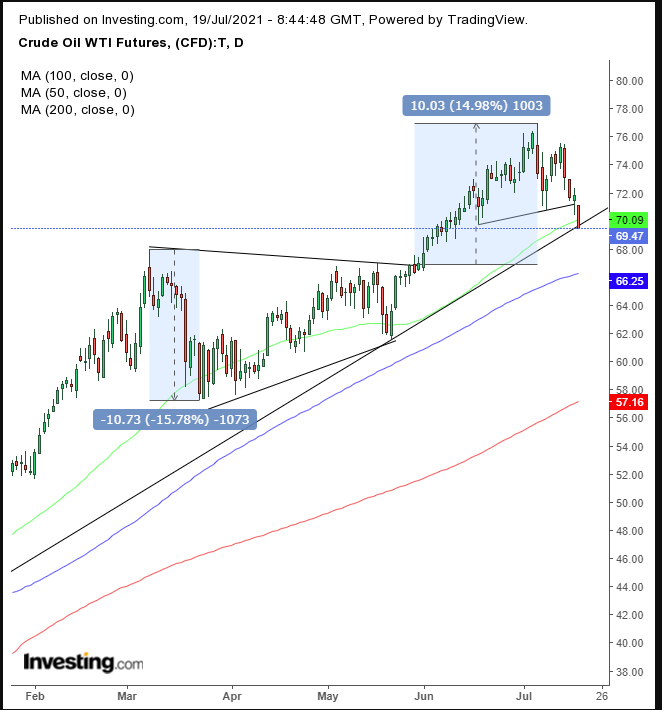- Unease persists that coronavirus and inflation will disrupt the recovery
- Oil fell below $70 on OPEC+ deal
- Dollar strength sees gold slide
Key Events
US futures contracts on the Dow, S&P, NASDAQ and Russell 2000 and stocks in Europe retreated Monday on concerns that the global economic recovery will fizzle out due to a resurgence of coronavirus via the fast-moving and highly contagious Delta variant, along with increased inflation. This anxiety weighed on markets during Friday's trade and persisted over the weekend. That may be a sign that this view is beginning to gain traction.
Oil fell after an OPEC+ breakthrough deal to increase supply; the dollar accelerated.
Global Financial Affairs
All four US futures were in the red, with those on the Russell 2000 1.8% deep, while NASDAQ contracts were outperforming, down just 0.6%. Since the small cap index is the focal point of stocks likely to benefit the most from a return to a normal economy, and technology firms see more profit during social restrictions, today’s trading pattern demonstrates a continued retraction of the reflation trade.
The pandemic weighed on European investors’ minds, as travel and leisure shares, along with basic resources, were the heaviest drag on the STOXX 600 Index, which extended a selloff to its fourth session—the longest losing streak for the pan-European index since October. The benchmark is moving toward a six-week low.

The index may be completing a double-top, following waning momentum, with the RSI triggering a negative divergence and proceeding to complete its own double top.
Earlier Monday, Asian benchmarks also extended a sellof, with the MSCI’s gauge of Asia-Pacific stocks falling to a weekly low, on the ongoing spread of the Delta strain in Asian countries, including Malaysia, Indonesia and Thailand, as well as parts of Japan, especially Tokyo, where the Olympics are scheduled to kick-off on Friday. Positive cases among athletes is souring sentiment there. This morning, the Nikkei 225 was down 1.25%.
One biotech that made its name because of the virus, Moderna (NASDAQ:MRNA), jumped 10.3% after news broke that the drugmaker will be added to the S&P 500 Index on July 21, resulting in an upside gap as portfolio managers will be forced to buy the stock in order to continue tracking the index.
Last week, US stocks suffered a weekly loss for the first time in a month, as investors seemed to shift focus from the economic growth driven by fiscal and monetary policy to actual economic data which showed inflation spiking even more than expected and declining sentiment outshadowing strong earnings releases.
The selloff in stocks didn't occur in a vacuum. Rather, investors rotated funds into Treasuries, pushing yields on the 10-year Treasury note yet lower, below 1.3% and toward 1.26%.

Yields are under considerable pressure, having completed a rising flag—whose significance is underscored by the 200 DMA’s failure to support the downside breakout—bearish after the previous plunge, itself a downside penetration of a symmetrical triangle which was also bearish following a top.
Perhaps, foreign Treasury buying boosted the dollar. The greenback neared, then surpassed 93.00 at time of writing, for the first time since early April.

A close above 94 will complete a large double bottom. Note the RSI’s congested decline, reminding us of a falling flag, bullish after a preceding jump. Due to USD strength—probably on increased demand for Treasuries—gold is falling for the second day, despite risk-off sentiment.

The yellow metal is attempting to provide a downside breakout to its rising wedge, after completing an Evening Star, which found resistance by a Death Cross.
Bitcoin trading was listless for the fourth day, hovering at $31,600.
Oil opened lower and continued to sell off, moving below $70, for the first time since early June, as OPEC+ reached a deal to increase output. Producers will pump another 400,000 barrels a day each month from August, while the UAE and others secured higher quotas starting May 2022.

WTI completed a small H&S top, which is now testing the uptrend line since the Nov. 2 low. The 50 DMA reinforces the support of the uptrend line, while the 100 DMA supports the preceding triangle, whose implied target was achieved.
Up Ahead
- The Reserve Bank of Australia meeting minutes are released on Tuesday.
- On Thursday, the European Central Bank announces its rate decision.
- The Bank of Indonesia also publishes its rate decision on Thursday.
- US existing home sales are released on Thursday.
- On Friday, the Tokyo Summer Olympics begin.
Market Moves
Stocks
- Futures on the S&P 500 fell 0.4%
- Futures on the NASDAQ 100 slipped 0.2%
- Futures on the Dow Jones Industrial Average dropped 0.5%
- The STOXX 600 declined 1.2%
- The MSCI World Index fell 0.5%
Currencies
- The Dollar Index rose 0.2%
- The euro fell 0.1% to $1.1789
- The British pound fell 0.3% to $1.3726
- The Japanese yen was little changed at 109.99 per dollar
Bonds
- The yield on 10-year Treasuries was little changed at 1.28%
- Germany’s 10-year yield was little changed at -0.36%
- Britain’s 10-year yield declined one basis point to 0.62%
Commodities
- West Texas Intermediate crude fell 1.5% to $70.75 a barrel
- Gold futures fell 0.6% to $1,803.80 an ounce
